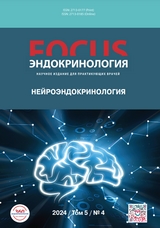
Professional medical scientific and practical specialized journal intended for internists and specialists in related areas.
The goal of the journal is to promote the professionalization of physicians, researchers, teachers at medical schools and educational institutions. The journal is focused on the diseases of internal organs, as well as on the issues related to multidisciplinary approach as the interrelated system of knowledge integration into management of patients with comorbidities.
Clinical reviews, including the cases difficult to diagnose, are published in the pages of the journal. In addition to clinical reviews, original research papers, lectures, and reviews on the most urgent issues of modern medicine, as well as interviews with experts in various fields of medicine are published.
The objectives of the journal are to report clinical observations, as well as to consider the issues related to new methods of patient assessment, efficiency of pharmacotherapy and non-pharmacological treatment, scientific research results, and methods to improve the efficiency of multidisciplinary approach to treatment of internal diseases.
The journal publishes the papers written by leading clinicians, the leaders in the appropriate fields of medicine in Russia and other countries.
The journal is intended for general practitioners, cardiologists, endocrinologists, gastroenterologists, pulmonologists, urologists, nephrologists, neurologists, rheumatologists, dermatologists and other specialists, as well as for clinical residents, postgraduate students and senior medical students.
Current issue
ORIGINAL RESEARCH
LITERATURE REVIEW
CLINICAL CASE
Announcements
2024-05-31
«FOCUS Эндокринология» вошел в ВАК!
Уважаемые члены редакционной коллегии журнала «FOCUS Эндокринология»!
Дорогие авторы и читатели нашего журнала!
Согласно рекомендациям президиума ВАК распоряжением Минобрнауки России от 20.05.2024г. №196-р издание «Focus Эндокринология» включено в «Перечень рецензируемых научных изданий, в которых должны быть опубликованы основные научные результаты диссертаций на соискание ученой степени кандидата наук, на соискание ученой степени доктора наук» по 8 научным специальностям:
- 3.1.18. Внутренние болезни (медицинские науки),
- 3.1.19. Эндокринология (медицинские науки),
- 3.1.20. Кардиология (медицинские науки),
- 3.1.20. Кардиология биологические науки),
- 3.1.30. Гастроэнтерология и диетология (медицинские науки),
- 3.1.31. Геронтология и гериатрия (медицинские науки),
- 3.1.32. Нефрология (медицинские науки)
- 3.1.24. Неврология (медицинские науки)
Ознакомиться с Перечнем можно на странице сайта Высшей аттестационной комиссии vak.minobrnauki.gov.ru
«Focus Эндокринология» - это профессиональное медицинское научно-практическое периодическое издание, посвященное вопросам применения междисциплинарного подхода как взаимообусловленной системы интеграции знаний в ведение коморбидных пациентов. На страницах журнала публикуются оригинальными статьи, лекции и обзоры по наиболее актуальным проблемам современной медицины, клинические разборы, а также интервью с экспертами в различных областях медицины. Журнал публикует статьи ведущих клиницистов – лидеров в соответствующих областях медицины России, стран ближнего и дальнего зарубежья.
Журнал издается с 2020 г c периодичностью 4 раза в год.
Включение журнала в данный перечень означает официальное признание журнала как весомого и признанного в научной среде издания.
Поздравляем редакционную коллегию, читателей и приглашаем авторов к публикации в журнале, имеющем новый статус – входящий в перечень ВАК!
С уважением,
главный редактор, профессор Т. Ю. Демидова
| More Announcements... |






















